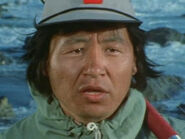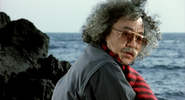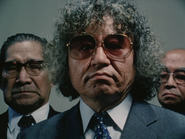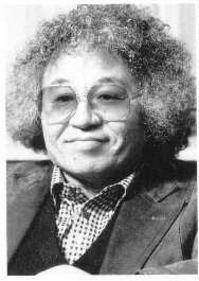
Shotaro Ishinomori
Shotaro Ishinomori (石ノ森 章太郎, Ishinomori Shōtarō, January 25, 1938–January 28, 1998) was a Japanese manga artist who became an influential figure in manga, anime, and tokusatsu, creating several immensely popular long-running series such as Cyborg 009 and Himitsu Sentai Gorenger![]() , what would go on to become part of the Super Sentai
, what would go on to become part of the Super Sentai![]() series, and the Kamen Rider Series. He was twice awarded by the Shogakukan Manga Award, in 1968 for Sabu to Ichi Torimono Hikae and in 1988 for Hotel and Manga Nihon Keizai Nyumon.
series, and the Kamen Rider Series. He was twice awarded by the Shogakukan Manga Award, in 1968 for Sabu to Ichi Torimono Hikae and in 1988 for Hotel and Manga Nihon Keizai Nyumon.
He was born as Shotaro Onodera (小野寺 章太郎, Onodera Shōtarō) in Tome, Miyagi, and was also known as Shotaro Ishimori (石森 章太郎, Ishimori Shōtarō) before 1986, when he changed his family name to Ishinomori, only with the inclusion of the "no" (ノ) katakana.
His grandson is Seiru, who portrayed a young Gai Amatsu in Kamen Rider Zero-One.
Background
Born Shotaro Onodera to Kotaro and Kashiku Onodera as their first son, Shotaro grew up in the town of Ishinomori in Tome, Miyagi Prefecture. His interest in manga started in middle school and started his own group with people called Bokuju Itteki (meaning a drop of ink) after a book by Shiki Masaoka. He would enter several manga-related competitions, even winning a few of them. In his first year of high school, Shotaro submitted a piece to Manga Shonen where it caught the attention of famed mangaka, Osamu Tezuka. Asked to be his assistant, Shotaro accepted, working before and after mid-terms. Working with Tezuka, Shotaro became involved with Toei, participating in the production of Journey to the West. Tezuka also introduced Shotaro to his future wife Toshiko. He also became involved with several other companies, establishing Studio Zero with Shinichi Suzuki and joining the Japan Cartoonists Association (eventually, becoming managing director). Thirty years after publishing 2nd Class Angel, Shotaro changed his family name to Ishimori. Eventually dying from heart failure, Ishinomori was awarded several awards including the Tezuka Osamu Cultural Prize.
Body of work
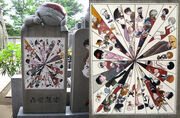
Ishinomori's Manga characters carved on the back of his tombstone,with the Kanji saying "Myriads of Things" (森羅萬象)
Cyborg 009, created in 1964, became the first superpowered hero team created in Japan. That same year, Kazumasa Hirai and Jiro Kuwata created Japan's first cyborg superhero, 8 Man (which predated Kamen Rider by eight years). The success of the tokusatsu superhero TV series Kamen Rider, produced by Toei Company Ltd. in 1971, led to the birth of the "henshin" (transforming) superhero (human-sized superheroes who transform by doing a pose, and use martial arts to fight henchmen and the weekly monster), and resulted in many sequel shows to this day. Ishinomori then created many superheroes and their dramas, including Kikaider , Henshin Ninja Arashi, Inazuman, Robotto Keiji![]() , Himitsu Sentai Gorenger
, Himitsu Sentai Gorenger![]() (the first Super Sentai series), Kaiketsu Zubat, Akumaizer 3, Poitrine and countless others. He even created popular children's shows such as Hoshi no Ko Chobin (Chobin, Child of the Stars, 1974, a co-production with Studio Zero which was a major success on Italian television), and Ganbare!! Robocon
(the first Super Sentai series), Kaiketsu Zubat, Akumaizer 3, Poitrine and countless others. He even created popular children's shows such as Hoshi no Ko Chobin (Chobin, Child of the Stars, 1974, a co-production with Studio Zero which was a major success on Italian television), and Ganbare!! Robocon![]() .
.
Ishinomori's art is quite reminiscent of that of his mentor, Osamu Tezuka. The true story of his first meeting with Tezuka was illustrated in a short four-page tale drawn up as supplementary material for the 1970s "Astro Boy" manga reprints. Around 1955, Ishinomori submitted work to a contest seeking new talent in the magazine, Manga Shonen. Tezuka was impressed by his drawings and asked Ishinomori to help him with Astro Boy. In the American release, this story can be seen in Volume 15, along with Ishinomori's earliest work on the "Electro" story arc.
There was also a The Legend of Zelda: A Link to the Past comic created for the U.S. Nintendo Power magazine by Shotaro Ishinomori. Loosely based on the game, this telling portrayed Link's parents as Knights of Hyrule, lost to the Dark World. It also included other original characters such as Link's fairy guide and companion, Epheremelda (long before this concept was introduced to the series, unless one counts the Super Mario Bros. Super Show's Legend of Zelda segments); and Roam, a descendant of the Knights of Hyrule who fought in the Imprisoning War. (Roam bears a striking resemblance to 002 from Cyborg 009 who could also fly as a result of changing into his beast form in the Dark World.) The comic ran as a serial in NP starting in January 1992 (Volume 32) and ran in 12 parts. It was later collected in graphic novel form.
Later life

Ishinomori promoting Kamen Rider ZO.
On March 27th 1993, Ishinomori made an appearance on TBS's Fight! Our Kamen Rider!- The Strongest Rider, ZO is Born!, telling the audience to see the film Kamen Rider ZO.
At the end of 1997, Kazuhiko Shimamoto, a young and up and coming mangaka was contacted by an increasingly ill Shotaro Ishinomori and asked if he would do a continuation (though more along the lines of a remake) of his 100-page, one-shot manga from 1970, Skull Man (the manga that became the basis for Kamen Rider). Ishinomori, who had been one of Shimamoto's boyhood heroes, faxed him copies of the proposed story and plot notes. Shimamoto was astounded that he had been chosen to work on his idol's final, great work.
Shimamoto had already been involved in the revival of one of Ishinomori's other earlier works (including Kamen Rider) but little did he dream that, as only one of many whom Ishinomori had inspired, he would be chosen for the final collaboration and resurrection of Skull Man. It was also adapted into an anime in 2007.
Death
Ishinomori died of heart failure on January 28, 1998. His final work was the tokusatsu superhero TV series, Voicelugger, televised months later. A manga museum named in his honor opened in Ishinomaki, Miyagi in 2001.
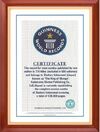
The certificate
His work posthumously awarded him the Guinness World Record for most comics published by one author, totaling over 128,000 pages.
Cameo in Kamen Rider Series
As one of the creators of Kamen Rider, Shotaro Ishinomori had made cameo apperances in the series.
- Kamen Rider - Episode 84: A fisherman, also the first victim of Isoginjaguar.
- Kamen Rider 1 Through RX: Big Gathering (archive footage only)
- Eight Riders vs. GingaOh - A crew of a ship.
- Kamen Rider Black: Hurry to Onigashima: A fisherman who helps Kotaro Minami travel to Onigashima.
- Shin Kamen Rider: Prologue: A spy who put some audiomonitors in the Foundation building.
Ghost Eyecon
Ishinomori Ghost Eyecon
Ishinomori also has a Ghost Eyecon in Kamen Rider Ghost toyline. The Eyecon shows his self-portrait on its Transformation Time setting. If inserted in the Ghost Driver, the belt will announce: "Pen to Kami! Sōzō no Kami!" (ペンと紙!創造の神! Pen and paper! God of creation!), starting with an energized explosion and ending with an epic orchestral rock music piece.
Appearances in fictional media
SD Battle Oozumou

Ishinomori's game sprite.
In the 1989 Banpresto Famicom crossover game, Shotaro Ishinomori is one of the background spectator sprites of the sumo arena.
The Osamu Tenka Story
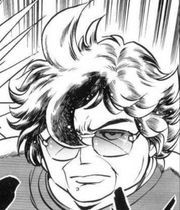
A short story by Kazuhiko Shimamoto featured in the Kamen Rider ZO Manga, Shotaro Ishinomori appears as a mentor to the fictitious caricature of Shimamoto, Osamu Tenka, who becomes Ishinomori's assistant and learns the secret to his legendary high speed drawing skills.
S.I.C HERO SAGA
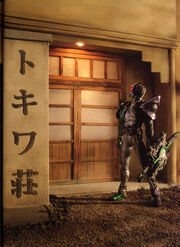
Ishinomori as Kamen Rider Double CycloneJokerXtreme Form at the Tokiwa-sō.
After many years from his death, Shotaro Ishinomori has a role in Kamen Rider W: Playback. In this novel, Shotaro was mistaken for another Shotaro by Philip from the original Kamen Rider W series, and later, transforms into Kamen Rider Double. This novel took place in a world for the people who have no bodies, in other words, a world storing human spirits.
Motifs/Themes
- Heroes with distinctive scarves (serve almost as miniature capes without the cumbersomeness)
- Showa Kamen Riders: Kamen Rider 1 (red), 2 (red), 3 (yellow), V3 (white), Riderman (yellow), X (black and yellow stripes with a red X), Amazon (white), Stronger (white), Skyrider (red), Super-1 (red), ZX (green)
- Cyborg 009: All the 00s (yellow)
- Henshin Ninja Arashi: Hayate (untransformed) (orange), Arashi (transformed) (purple)
- Kaiketsu Zubat (white)
- Inazuman (yellow) and Inazuman Flash (orange)
- Akumaizer 3: Zabitan (white) and Evil (red)
- Chôjin Bibyun (sequel of Akumaizer 3): Bibyun (brownish beige, normally green)
- Anti-heroes early for their time: Skull Man, some aspects of Hakaider of Kikaida series, Cyborg 0013 of Cyborg 009 series
- Heroes torn between humanity and inhumanity (influenced by Osamu Tezuka's Astro Boy [itself a basis of Pinocchio], and Mary Shelley's Frankenstein): Cyborg 009 series, Kamen Rider series, Kikaider series
- Egg/oval shaped eyes: Kamen Rider series, Kikaider series, Robot Detective, Henshin Ninja Arashi series, Skull Man, Inazuman series, Evil of Akumaizer 3, Chôjin Bibyun series
- Skull/skeleton: Black Ghost (Cyborg 009), Skull Man, Shocker and Destron style soldiers (Kamen Rider 1/2/V3), Skull Rider
- The few underdog heroes vs. an evil organization that dominates every facet of the world
- The irony of turning those who were intended for evil to fight for justice and define a new life purpose.
External links
 Shotaro Ishinomori at Wikipedia.
Shotaro Ishinomori at Wikipedia.- Shotaro Ishinomori
 at RangerWiki
at RangerWiki
- Shotaro Ishinomori
 at the Kikaider Wiki
at the Kikaider Wiki
- Shotaro Ishinomori
 at the Inazuman Wiki
at the Inazuman Wiki
- Ishimori Production Inc. - Official website (Japanese)
- Ishimori Production Inc. - Official website
- Ishimori Production Inc. - Official website (France)
- Mangattan Museum website (Japanese)
- Shotaro Ishinomori Complete Comic Works (Japanese)
- Shotaro Ishinomori Memorial Museum - Official website (Japanese)
- Entry in the Encyclopedia of Science Fiction

